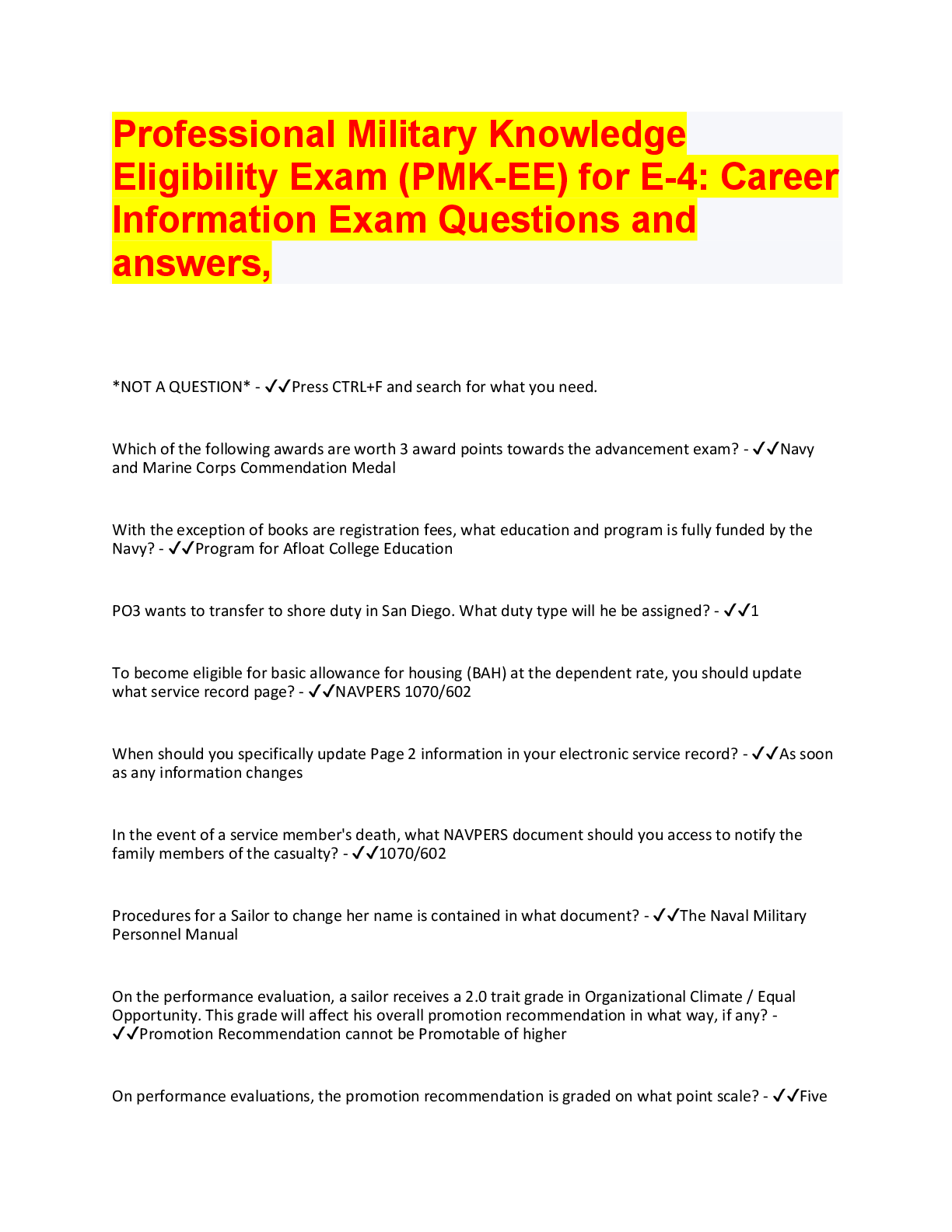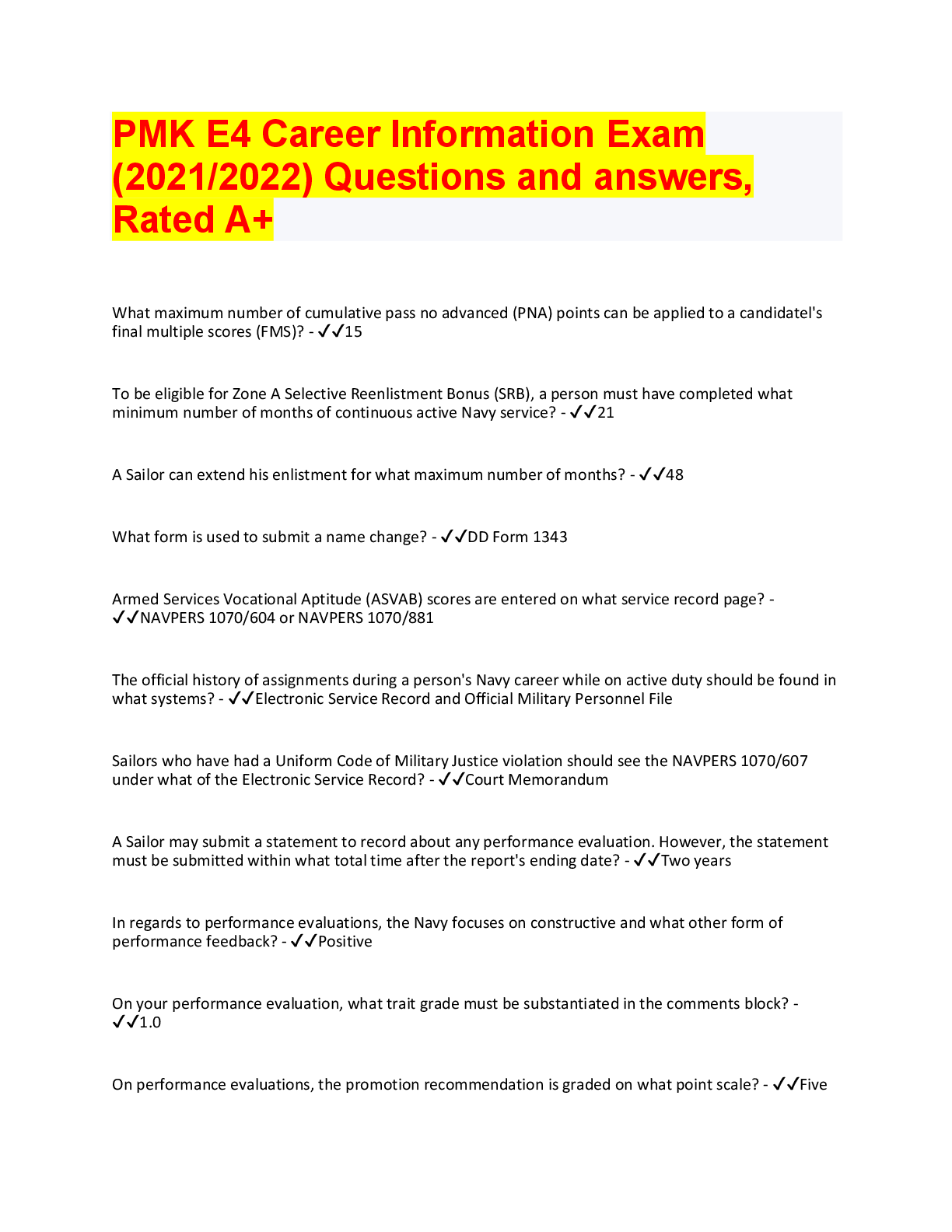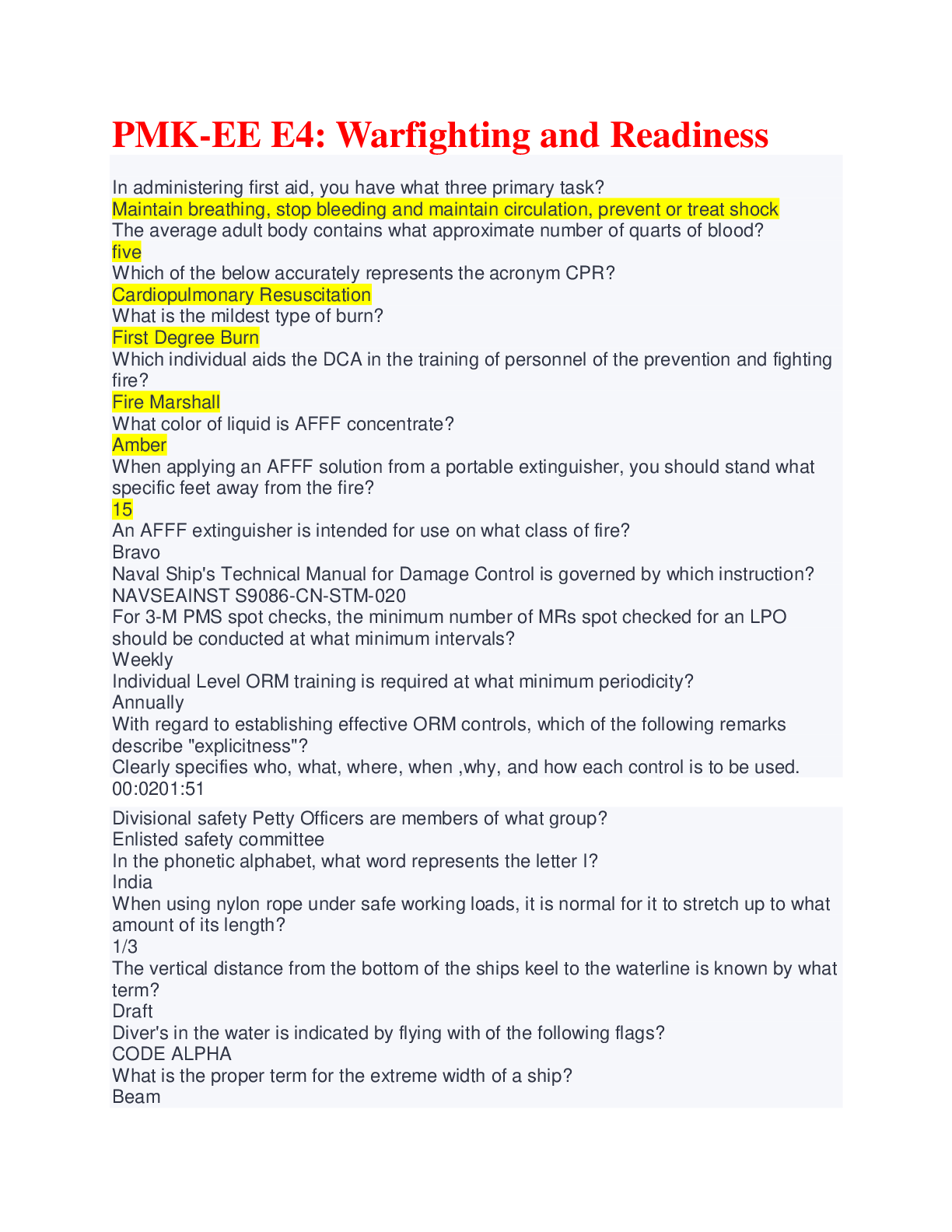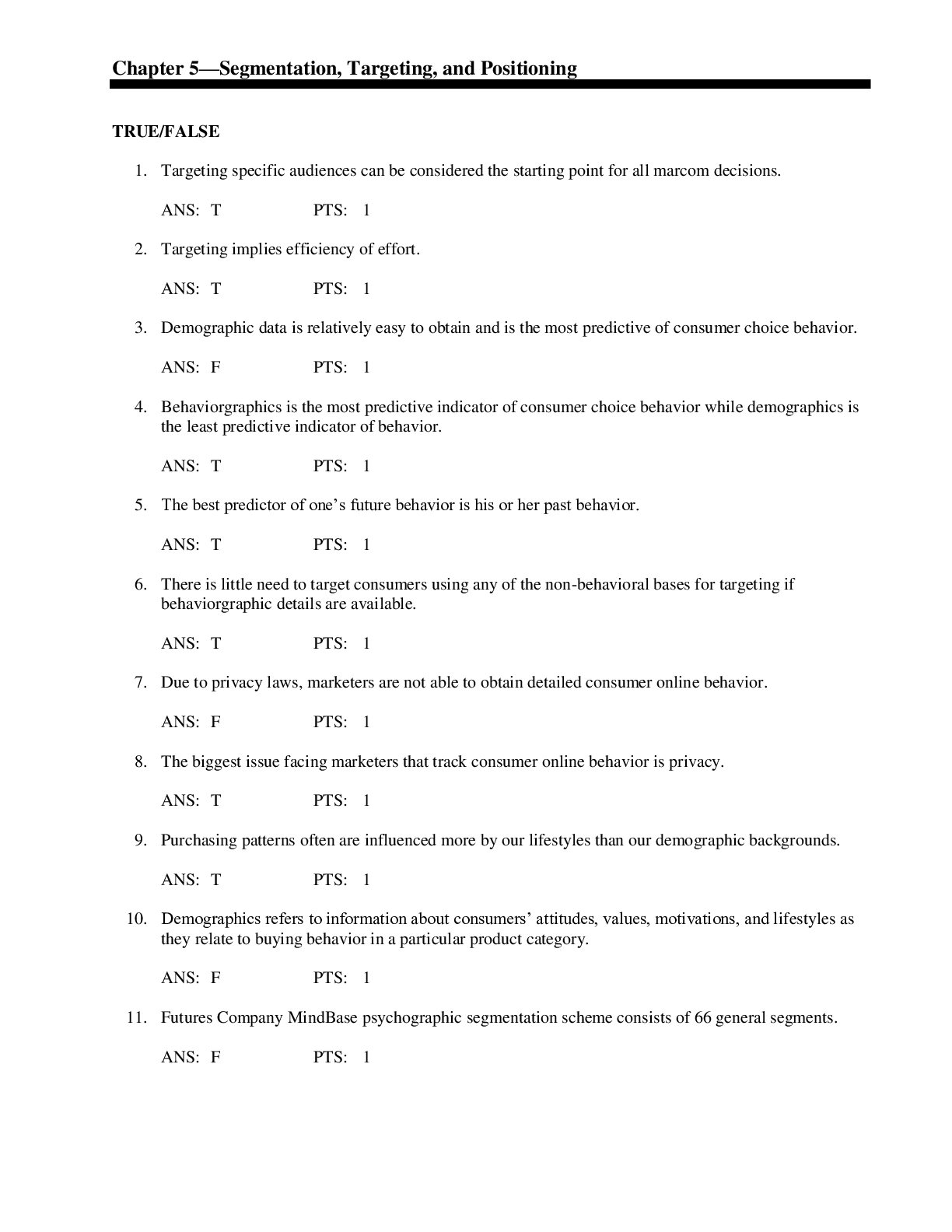Procurement > QUESTIONS & ANSWERS > WGU C720 Operations and Supply Chain Management – Questions and Answers Already Passed (All)
WGU C720 Operations and Supply Chain Management – Questions and Answers Already Passed
Document Content and Description Below
WGU C720 Operations and Supply Chain Management – Questions and Answers Already Passed Operations ✔✔The process used to acquire inputs, such as people, capital, and material, and transform t... hem into outputs, such as products and services. Operations Manager ✔✔They allocate resources. Capital ✔✔Facilities and equipment Competitive Advantage ✔✔Developing capabilities that customers value, can be sustained over the long-term, and competitors find difficult to replicate. Inseparability ✔✔The process of separating production from consumption; cannot be done for services because they are produced and consumed simultaneously. Technology ✔✔The application of knowledge, tools, processes, and procedures to solve problems. Product Design ✔✔The characteristics, features, and performance of the product; how the product functions; does not fundamentally change the product. Example: changing Coca-Cola's beverage containers from glass to aluminum. Product Technology ✔✔The application of knowledge to improve the product. Process ✔✔How to accomplish a task.Process Design ✔✔How a product is made; can fundamentally alter the nature of the product. Example: changing the taste of Coca-Cola. Process Technology ✔✔The application of knowledge to improve a process. Cross-Functionality ✔✔When individuals with different expertise work towards a common goal; this is an essential business process. Concurrent Engineering ✔✔Completing product design and process design simultaneously. Functional Areas ✔✔Subsystems within an organization, such as marketing, finance, and accounting, that are linked together by a common organizational goal. Strategy ✔✔Consists of the organizational goals and the methods of implementing the goals; every element of the SWOT analysis should be considered when developing strategies. Key Policies ✔✔Main goals of an organization. Organizational Structure ✔✔The formal relationships among different functional areas that aids in communication. Relative Advantage ✔✔Where one entity has an advantage over another; will often trade their specialized products for those that they do not produce; companies with a relative advantage are able to produce products at a lower cost than their competitors. North American Free Trade Agreement (NAFTA) ✔✔A free trade agreement between the United State, Mexico, and Canada to reduce tariffs and other trade restrictions.General Agreement on Tariffs and Trade (GATT) ✔✔A trade agreement designed to reduce tariffs and other trade restrictions. Sustainability ✔✔Balancing the interconnected obligations to economic viability, society, and the environment (the triple bottom line). What is the percentage of businesses that operate within the service sector? ✔✔88 percent Supporting Goods ✔✔Supplies and equipment that aid in the development of products and services. Market Share ✔✔The percentage of sales in a particular market. VIRAL ✔✔Value, Inimitable, rare, aptitude, and lifespan. SWOT Analysis ✔✔Analyzing the internal (strengths and weaknesses) and external (opportunities and threats) environments. Requirements for developing competitive advantage ✔✔SWOT, business process, competitive capabilities, and customer requirements. Learning Curve ✔✔Continuously improving a product to make it better and cheaper. Synergy ✔✔Teamwork where the whole is greater than the sum of its parts. Key Processes ✔✔Strategy development, product development, system development, and order fulfillment. System ✔✔The process of producing goods and system.Matching ✔✔Matching strengths to opportunities. Converting ✔✔Converting weaknesses or threats into strengths or opportunities. Productivity ✔✔Output / Input; the goal is achieving more output given the amount of inputs, thus saving money and reducing production costs. The First Revolution ✔✔Starting in the late 1800s, increases in manufacturing productivity reduced the need for physical labor and enabled a shift towards service-based jobs. The Second Revolution ✔✔Productivity and efficiency improvements in manufacturing freed resources for the rapid expansion of the service industry. The Third Revolution ✔✔Also known as the post-industrial era, this revolution began in the 1950s with the development of computers. This technology has allowed fewer people to do more work. Reliability ✔✔The ability to perform dependably and accurately. Assurance ✔✔Knowledge and courtesy of employees and their ability to convey trust and confidence. Process Redesign ✔✔The complete overhaul of a process to improve performance. Percent Change in Productivity ✔✔[(New Productivity - Old Productivity)/Old Productivity] * 100 Quality (internal) ✔✔How quality is defined by the business; often measured as the amount of a desired attribute; objective.Quality (external) ✔✔How quality is defined by the customer and the product's fitness for use; meets customer's needs and expectations; subjective. Questions for Customers when Improving Products ✔✔Ask what they value (not just what they want), how do they work, what makes them happy, and feedback on specific product attributes. Costs of Quality ✔✔Failure costs, appraisal costs, and prevention costs. Failure Costs ✔✔Costs accrued by the organization or customer as the result of a failure of the product. Appraisal Costs ✔✔Investments in measuring quality and assessing customer satisfaction. Prevention Costs ✔✔Investments designed to prevent defects from occurring. Poka-yoke ✔✔Mistake proofing; an approach to prevent defects, such as color-coding parts so that customers assemble the product correctly. Design for Manufacture and Assembly (DFMA) ✔✔Products should be designed so that they are simple and inexpensive to produce. Design for Operations (DFO) ✔✔Services should be simple and inexpensive. Statistical Process Control (SPC) ✔✔The use of statistical methods to determine when a process that produces goods is getting close to producing too many defects. W. Edwards Deming ✔✔The most influential individual within the specialty of quality; After World War II, he went to Japan to help rebuild their economy, and he was heralded for hisinfluence. He went on to lecture in the United States in the 1980s; he developed his 14 Points for the Transformation of Management. Deming's 14 Points for the Transformation of Management ✔✔The system, not employees, cause defects; management is responsible for changing the system, and they must take responsibility instead of blaming employees; Deming also stressed the use of Statistical Process Control (SPC) and encouraged training in its use. Other highlights include creating purpose, reduce fear, provide training and leadership, break down barriers between departments, and eliminate slogans, work standards, and quotas. Joseph M. Juran ✔✔He defined quality as "fitness for use", from the customer's perspective; he emphasized the need for continuous improvement and stressed that quality must be built on quality planning, quality control, and quality improvement. Quality Planning ✔✔The development of products that appeal to the changing wants and needs of customers. Quality Control ✔✔Ensure that the product fits the customer's perception of fitness for use. Quality Improvement ✔✔Leadership ought to lead efforts to eliminate waste and errors. Philip Crosby ✔✔Wrote Quality is Free; he emphasized the complete elimination of failures to save money, as most firms underestimate their failure costs and should evaluate all costs of quality; "Do it right the first time". Genichi Taguchi ✔✔He helped develop Japan's telephone system post-World War II. He designed experiments to extract more data from each test. He argues for "robust design", designs that guarantee high quality despite variations, such as employee errors, that may occur during the processes that produce the product; quality must, therefore, be built into the product.Kaoru Ishikawa ✔✔He developed the Ishikawa/Fishbone diagram and quality circles. Ishikawa/Fishbone Diagram ✔✔Helps establish cause-and-effect by identifying factors that contribute to outcomes or problems; the factors are categories as People, Machines, Methods, Measurements, Materials, and Environment and include intentional and unintentional consequences and influence quality performance. Quality Circles ✔✔A team from all levels who meet to discuss, analyze, and eliminate quality issues using Deming's 14 points; a senior manager overseas their progress and approves their changes. Total Quality Management (TQM) ✔✔An organization-wide philosophy that calls for 1) focusing on the customer, 2) quality function deployment, 3) responsibility for quality, 4) team problemsolving, 5) employee training, and 6) fact-based management. Voice of the Customer ✔✔Describes what customers want and what they like and dislike; can get to know customers, hold focus groups, and request improvement suggestions; the business can also use their knowledge of how the customer would benefit from a new technology that they are not familiar with to create a future need on behalf of the customer. Quality Function Deployment (QFD) ✔✔Relating customer needs and expectations to specific design characteristics through a series of grids or matrices. House of Quality ✔✔The matrix used in Quality Function Deployment (QFD); lists customer needs (WHATs), design characteristics related to these needs (HOWs), the nature of the relationship between each customer's need and design characteristic (WHAT versus HOW), the reasons for WHATs (WHYs), and performance comparisons on design characteristics against competitors (HOW MUCH).Quality Control Department ✔✔Where quality control obligations traditionally fell; now, it is up to everyone to ensure quality. Standardization ✔✔Developing a preset procedure. Documentation ✔✔The act of putting a procedure into writing. ISO 9000 ✔✔2000: An international quality standard. Plan-Do-Check-Act Cycle/Deming Wheel/Shewhart Cycle ✔✔A cycle of continuous improvement that is repeated indefinitely. Planning involves using appropriate tools to identify problems or improvement opportunities. Doing involves acting upon the plan. Checking involves analyzing the actions performed to ensure that goals were achieved. Acting involves standardizing and documenting the changes, communicating changes to other, and determining why goals were not achieved. Seven Tools of Statistical Process Control (SPC) ✔✔Fishbone diagrams, check sheets, control charts, histograms, Pareto charts, scatter diagrams, and control charts (classified as flow/run charts). Check Sheets ✔✔Used to record data points in real-time at the site where the data is generated; raw data is collected without interpretation and then depicted using a different statistical tool. Histogram/Box Chart ✔✔Shows the frequency of data observations within a preset range of val [Show More]
Last updated: 2 years ago
Preview 1 out of 26 pages

Buy this document to get the full access instantly
Instant Download Access after purchase
Buy NowInstant download
We Accept:

Also available in bundle (1)

WGU C720 Operations and Supply Chain Management BUNDLE – Questions and Answers, 100% ACCURATE. RATED A
COMPRISE OF EXAMINABLE QUESTIONS WITH ACCURATE ANSWERS, RATED A.
By bundleHub Solution guider 2 years ago
$20
21
Reviews( 0 )
$8.00
Can't find what you want? Try our AI powered Search
Document information
Connected school, study & course
About the document
Uploaded On
Sep 30, 2022
Number of pages
26
Written in
Seller

Reviews Received
Additional information
This document has been written for:
Uploaded
Sep 30, 2022
Downloads
0
Views
186

























